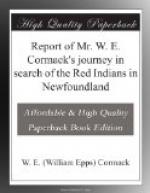Their wooden repositories for the dead are what are in the most perfect state of preservation. These are of different constructions, it would appear, according to the character or rank of the persons entombed. In one of them, which resembled a hut, ten feet by eight or nine, and four or five feet high in the centre, floored with squared poles, the roof covered with rinds of trees, and in every way well secured against the weather inside and the intrusion of wild beasts, there were two grown persons laid out at full length on the floor, the bodies wrapped round with deer-skins. One of these bodies appeared to have been placed here not longer ago than five or six years. We thought there were children laid in here also. On first opening this building, by removing the posts which formed the ends, our curiosity was raised to the highest pitch; but what added to our surprise, was the discovery of a white deal coffin, containing a skeleton neatly shrouded in white muslin. After a long pause of conjecture how such a thing existed here, the idea of Mary March occurred to one of the party, and the whole mystery was at once explained[B].
In this cemetery were deposited a variety of articles, in some instances the property, in others the representations of the property and utensils, and of the achievements, of the deceased. There were two small wooden images of a man and woman, no doubt meant to represent husband and wife; a small doll, which we supposed to represent a child (for Mary March had to leave her only child here, which died two days after she was taken): several small models of their canoes; two small models of boats; an iron axe; a bow and quiver of arrows were placed by the side of Mary March’s husband; and two fire-stones (radiated iron pyrites, from which they produce fire, by striking them together) lay at his head; there were also various kinds of culinary utensils, neatly made, of birch-rind, and ornamented; and many other things, of some of which we did not know the use or meaning.




